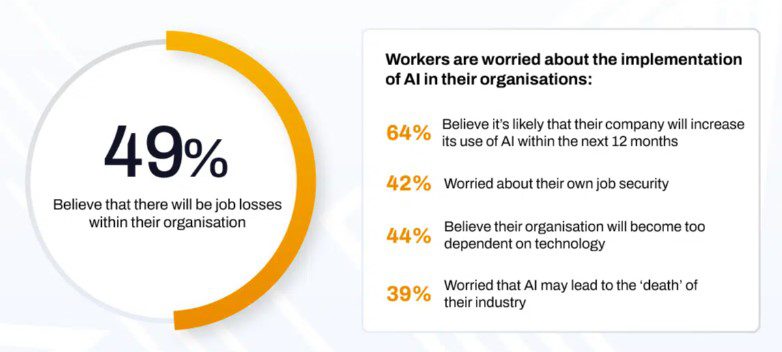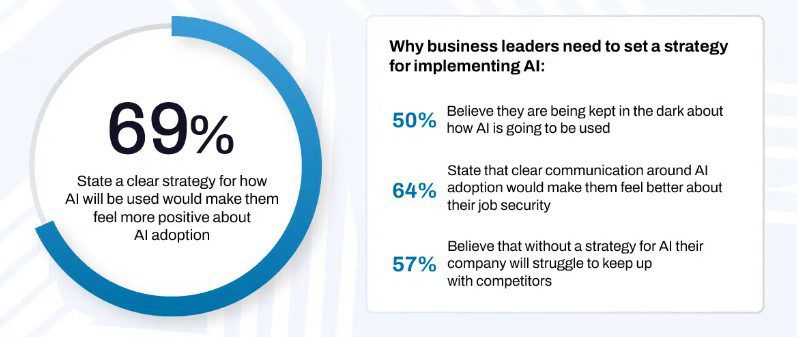Be transparent about AI in the workplace
And embrace upskilling in digital.
Why You Should Care
Generative AI will transform the world of work forever.
And employees are worried, according to Zokri research.
Here's how to alleviate those concerns!
Generative AI is the term of the moment.
It has huge potential to disrupt our working lives – but will it do so for the better or worse? Will it replace humans, or will it simply make them more efficient?
While research from Microsoft suggests that generative AI, exemplified by the likes of Google’s BARD and OpenAI’s ChatGPT, will be our copilot in the future of work – it frees humans up to lean into their unique skills and capabilities – there are still concerns about its impact on the labor market.
Half of the 2,000 UK and US workers surveyed by software development platform Zokri believe that generative AI will cause job losses – and 42% are personally worried about their future job security.

Credit: Zokri.
These concerns are valid; just this week employers like IBM and BT have announced job cuts linked with AI.
In an interview with Bloomberg, IBM CEO Arvind Krishna said that tech giant is going to slow or suspend hiring for jobs that could be done by AI. He predicted this could be 30% of IBM’s workforce, meaning AI may replace up to 7,800 jobs.
While BT is planning to replace 10,000 jobs with AI – the focus is on areas like customer service.
CEO Philip Jansen commented: “Whenever you get new technologies you can get big changes”.
He added that generative AI tools “gives us confidence we can go even further”, and make services better, faster and more seamless.
It’s time for transparency and L&D
While there will be some job that are lost to AI, there is a lot that employers can do to support (and prepare) their employees better for the next wave of AI.
First, they can communicate clearly and transparently about how they are going to use AI in the workplace.
Zokri’s research shows that generative AI has lots of use cases in areas like research (28%), summarizing large data sets (24%), writing copy and code (22%) and customer service (25%) – but that doesn’t mean all of these are relevant for every company.
Having a clear communication strategy around AI would make 69% of employees feel more positive about AI, and 64% would particularly feel better about their job security.
Second, now is the time to focus on digital upskilling. While research by Udemy shows that employees are already ahead of the curve and looking to upskill around ChatGPT, it is time for companies to step up to help all workers upskill in AI.
This is beneficial not just for the employee, and ensuring their skills remain up-to-date as the world becomes even more digitized, but also the organization as a whole.
Zokri’s data shows that 57% of organizations are worried that if they don’t have a clear organizational strategy around AI then they will struggle to keep up with their competitors in the future.

Credit: Zokri.
Ironically, generative AI itself can help organizations identify skill gaps, and the right training for their employees.
Learning and development is a key focus of HR tech vendors who are integrating generative AI into their products. For instance, SAP SuccessFactors is working with Microsoft to leverage generative AI-powered Copilot in Viva Learning to personalize learning recommendations based on data and the employee’s unique development goals.
And now digital learning provider GoodHabitz has integrated OpenAI’s ChatGPT into its platform. Talking about the announcement, GoodHabitz’ CEO, Maarten Franken, said: “ChatGPT-powered features are an exciting contribution to the GoodHabitz solution, offering an entirely new level of learning that was not possible before.
“We believe that innovation and technology hold the key to the future of learning.”
Want to find out the latest on generative AI and the world of work, check out all our latest news and analysis here.
Sign up to the UNLEASH Newsletter
Get the Editor’s picks of the week delivered straight to your inbox!

Chief Reporter
Allie is an award-winning business journalist and can be reached at alexandra@unleash.ai.
